Related Research Articles

Chondrichthyes is a class of jawed fish that contains the cartilaginous fish or chondrichthyans, which all have skeletons primarily composed of cartilage. They can be contrasted with the Osteichthyes or bony fish, which have skeletons primarily composed of bone tissue. Chondrichthyes are aquatic vertebrates with paired fins, paired nares, placoid scales, conus arteriosus in the heart, and a lack of opercula and swim bladders. Within the infraphylum Gnathostomata, cartilaginous fishes are distinct from all other jawed vertebrates.
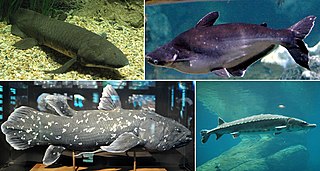
Osteichthyes, also known as osteichthyans or commonly referred to as the bony fish, is a diverse superclass of vertebrate animals that have endoskeletons primarily composed of bone tissue. They can be contrasted with the Chondrichthyes and the extinct placoderms and acanthodians, which have endoskeletons primarily composed of cartilage. The vast majority of extant fish are members of Osteichthyes, being an extremely diverse and abundant group consisting of 45 orders, over 435 families and 28,000 species. It is the largest class of vertebrates in existence today, encompassing most aquatic vertebrates, as well as all semi-aquatic and terrestrial vertebrates.

In zoology, a scale is a small rigid plate that grows out of an animal's skin to provide protection. In lepidopterans, scales are plates on the surface of the insect wing, and provide coloration. Scales are quite common and have evolved multiple times through convergent evolution, with varying structure and function.

Lungfish are freshwater vertebrates belonging to the class Dipnoi. Lungfish are best known for retaining ancestral characteristics within the Osteichthyes, including the ability to breathe air, and ancestral structures within Sarcopterygii, including the presence of lobed fins with a well-developed internal skeleton. Lungfish represent the closest living relatives of the tetrapods. The mouths of lungfish typically bear tooth plates, which are used to crush hard shelled organisms.
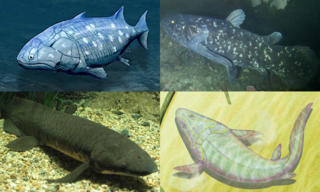
Sarcopterygii — sometimes considered synonymous with Crossopterygii — is a clade of vertebrate animals which includes a group of bony fish commonly referred to as lobe-finned fish. These vertebrates are characterised by prominent muscular limb buds (lobes) within their fins, which are supported by articulated appendicular skeletons. This is in contrast to the other clade of bony fish, the Actinopterygii, which have only skin-covered bony spines supporting the fins.

Dentin or dentine is a calcified tissue of the body and, along with enamel, cementum, and pulp, is one of the four major components of teeth. It is usually covered by enamel on the crown and cementum on the root and surrounds the entire pulp. By volume, 45% of dentin consists of the mineral hydroxyapatite, 33% is organic material, and 22% is water. Yellow in appearance, it greatly affects the color of a tooth due to the translucency of enamel. Dentin, which is less mineralized and less brittle than enamel, is necessary for the support of enamel. Dentin rates approximately 3 on the Mohs scale of mineral hardness. There are two main characteristics which distinguish dentin from enamel: firstly, dentin forms throughout life; secondly, dentin is sensitive and can become hypersensitive to changes in temperature due to the sensory function of odontoblasts, especially when enamel recedes and dentin channels become exposed.

Eusthenopteron is a genus of prehistoric sarcopterygian fish known from several species that lived during the Late Devonian period, about 385 million years ago. It has attained an iconic status from its close relationship to tetrapods. Early depictions of animals of this genus show them emerging onto land, but paleontologists now think that eusthenopteron species were strictly aquatic animals, though this is not completely known.

Cheirolepis is an extinct genus of marine and freshwater ray-finned fish that lived in the Devonian period of Europe and North America. It is the only genus yet known within the family Cheirolepididae and the order Cheirolepidiformes. It was among the most basal of the Devonian actinopterygians and is considered the first to possess the "standard" dermal cranial bones seen in later actinopterygians.
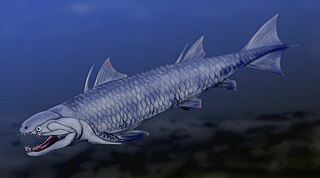
Psarolepis is a genus of extinct bony fish which lived around 397 to 418 million years ago. Fossils of Psarolepis have been found mainly in South China and described by paleontologist Xiaobo Yu in 1998. It is not known certainly in which group Psarolepis belongs, but paleontologists agree that it probably is a basal genus and seems to be close to the common ancestor of lobe-finned and ray-finned fishes. In 2001, paleontologist John A. Long compared Psarolepis with onychodontiform fishes and refer to their relationships.

Styloichthys is a prehistoric sarcopterygian, lobe-finned fish which lived during the Early Devonian (Lochkovian) period of East Yunnan, South China.
Andreolepis is an extinct genus of prehistoric fish, which lived around 420 million years ago. It was described by Walter Gross in 1968 based on scales found in the Hemse Formation in Gotland, Sweden. It is placed in the monogeneric family Andreolepididae and is generally regarded as a primitive member of the class Actinopterygii based on its ganoid scale structure; however some new research regards it as a stem group of osteichthyans.
The Xitun Formation is a palaeontological formation which is named after Xitun village in Qujing, a location in South China. This formation includes many remains of fossilized fish and plants of the Early Devonian period. It was originally referred to as the Xitun Member of the Cuifengshan Formation.
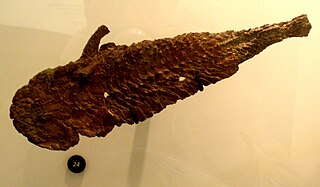
Megalichthyidae is an extinct family of tetrapodomorphs which lived from the Middle–Late Devonian to the Early Permian. They are known primarily from freshwater deposits, mostly in the Northern Hemisphere, but one genus (Cladarosymblema) is known from Australia, and the possible megalichthyid Mahalalepis is from Antarctica.
Guiyu oneiros is one of the earliest articulated bony fish discovered. Fossils of Guiyu have been found in what is now Qujing, Yunnan, China, in late Silurian marine strata, about 425 million years old.
Dialipina is an extinct genus of prehistoric marine bony fish from the Early Devonian. It contains two species, both known from the high Arctic of Asia and North America. It was initially thought to be and sometimes still is treated as an early, basal actinopterygian, but recent phylogenetic analyses suggest that it may instead be a stem-osteichthyan.

The skull roof or the roofing bones of the skull are a set of bones covering the brain, eyes and nostrils in bony fishes and all land-living vertebrates. The bones are derived from dermal bone and are part of the dermatocranium.
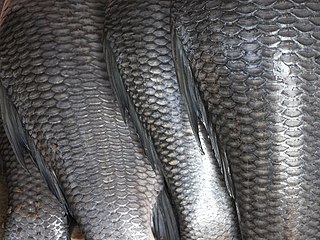
A fish scale is a small rigid plate that grows out of the skin of a fish. The skin of most jawed fishes is covered with these protective scales, which can also provide effective camouflage through the use of reflection and colouration, as well as possible hydrodynamic advantages. The term scale derives from the Old French escale, meaning a shell pod or husk.

Fins are moving appendages protruding from the body of fish that interact with water to generate thrust and help the fish swim. Apart from the tail or caudal fin, fish fins have no direct connection with the back bone and are supported only by muscles.

Ganoine or ganoin is a glassy, often multi-layered mineralized tissue that covers the scales, cranial bones and fin rays in some non-teleost ray-finned fishes, such as gars and bichirs, as well as lobe-finned coelacanths. It is composed of rod-like, pseudoprismatic apatite crystallites, with less than 5% of organic matter. Existing fish groups featuring ganoin are bichirs and gars, but ganoin is also characteristic of several extinct taxa. It is a characteristic component of ganoid scales.
Cladistic classification of Sarcopterygii is the classication of Sarcopterygii as a clade containing not only the lobe-finned fishes but also the tetrapods, which are closely related to lungfish. The taxon Sarcopterygii was traditionally classified as a paraphyletic group considered either a class or a subclass of Osteichthyes. Identification of the group is based on several characteristics, such as the presence of fleshy, lobed, paired fins, which are joined to the body by a single bone.
References
- ↑ Schultze, Hans-Peter (2016-01-01). "Scales, Enamel, Cosmine, Ganoine, and Early Osteichthyans". Comptes Rendus Palevol. 15 (1–2): 83–102. doi: 10.1016/j.crpv.2015.04.001 . ISSN 1631-0683.
- ↑ Williamson, W. C. (1849). "On the Microscopic Structure of the Scales and Dermal Teeth of Some Ganoid and Placoid Fish". Philosophical Transactions of the Royal Society of London. 139: 435–475. Bibcode:1849RSPT..139..435W. doi: 10.1098/rstl.1849.0023 . JSTOR 108487.
- 1 2 3 (geologist.), Walter Gross (1956). Über Crossopterygier und Dipnoer aus dem baltischen Oberdevon im Zusammenhang einer vergleichenden Untersuchung des Porenkanalsystems paläozoischer Agnathen und Fische (in German). Almqvist & Wiksell.
- ↑ Donoghue, Philip C.J. "Evolution of Development of the Vertebrate Dermal and Oral Skeletons: Unraveling Concepts, Regulatory Theories, and Homologies" (PDF).[ permanent dead link ]
- ↑ Goodrich, Edwin S. (1907-05-01). "On the Scales of Fish, Living and Extinct, and their importance in Classification". Proceedings of the Zoological Society of London. 77 (4): 751–773. doi:10.1111/j.1469-7998.1907.tb06953.x. ISSN 1469-7998.
- 1 2 Ørvig, Tor (1969-09-01). "Cosmine and Cosmine Growth". Lethaia. 2 (3): 241–260. doi:10.1111/j.1502-3931.1969.tb01850.x. ISSN 1502-3931.
- ↑ Bemis, William; Glenn Northcutt, R (2010-04-22). "Skin and Blood Vessels of the Snout of the Australian Lungfish, Neoceratodus forsteri, and their Significance for Interpreting the Cosmine of Devonian Lungfishes". Acta Zoologica. 73 (2): 115–139. doi: 10.1111/j.1463-6395.1992.tb00956.x .
- ↑ Zhu, Min; Yu, Xiaobo; Wang, Wei; Zhao, Wenjin; Jia, Liantao (2006). "A primitive fish provides key characters bearing on deep osteichthyan phylogeny". Nature. 441 (7089): 77–80. Bibcode:2006Natur.441...77Z. doi:10.1038/nature04563. ISSN 1476-4687. PMID 16672968. S2CID 1840338.
- ↑ Lu, Jing; Giles, Sam; Friedman, Matt; den Blaauwen, Jan L.; Zhu, Min (2016-06-20). "The Oldest Actinopterygian Highlights the Cryptic Early History of the Hyperdiverse Ray-Finned Fishes". Current Biology. 26 (12): 1602–1608. doi: 10.1016/j.cub.2016.04.045 . ISSN 0960-9822. PMID 27212403.
- ↑ Qu, Qingming; Sanchez, Sophie; Zhu, Min; Blom, Henning; Ahlberg, Per Erik (2017-05-01). "The origin of novel features by changes in developmental mechanisms: ontogeny and three-dimensional microanatomy of polyodontode scales of two early osteichthyans". Biological Reviews. 92 (2): 1189–1212. doi:10.1111/brv.12277. ISSN 1469-185X. PMID 27194072. S2CID 3497774.